What is the significance of a pedestrian crossing sign? Signs: pedestrian crossing, artificial hump, bus stop
October 16th, 2014 , 01:48 pm
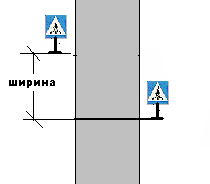
Yesterday I was visiting a friend and we argued a little with her about the topic of a pedestrian crossing. And then an argument began with my husband... In general, I myself am inclined to believe that most likely I am still wrong, and yet I decided to clarify this issue for myself completely.
And the question is: where should a pedestrian cross the road if there is a zebra crossing and there is a pedestrian crossing zone?
Now you’re going to say that I didn’t learn traffic rules or what?
No, I taught and even passed the driving test without a single mistake, and I know the signs better than my husband, but apparently I haven’t figured out the issues of the pedestrian crossing zone yet.
Therefore, I really want to hear your opinion on the following situation.
In front of you - unregulated intersection unequal roads (in your own words - this is when there are no traffic lights and traffic controllers and one road is the main one, and adjoining it are not the main roads). There are stops on both sides of the road.
One side of the road (above the intersection)- zebra crossing markings directly opposite the stop on the main road. On the other side of the same main road- “pedestrian crossing” sign.
The other side of the road (below the intersection)- there are no markings on the main road, but there are 2 crossing signs and a zebra crossing on the side road (which intersects with the main road) - one on one side of the zebra crossing, the other on the other. But one pedestrian crossing sign, which stands opposite the stop, is turned towards the main road, so if you leave the stop you immediately see it. There is no zebra there, but when they see this sign, many people immediately begin to cross the road along it.
It turns out that the expanded sign near the zebra crossing on the right side of the road and the pedestrian crossing sign on the left side of the road form Pedestrian crossing area, on the section of which you can cross the road... Or still there is no Transition Zone if there is a Zebra crossing and crossing is possible only along it?
In general, this is the situation. It’s hard to describe in words, I don’t know if you fully understood the placement of the signs, you had to take a photo of the road...
But the main thing here is probably not even in the arrangement of signs, but in the fact Pedestrians should cross the road at a zebra crossing or in a pedestrian crossing zone? But we must also take into account the fact that the markings and signs are placed incorrectly:
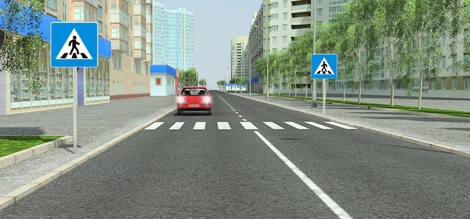
And on each side of the intersection...
I googled and got different answers on the forums, some wrote:
Someone writes that the traffic police oblige the driver to stop up to 15 meters before the zebra crossing, and passing pedestrians in these places is strictly deprived of their rights, and someone writes that 5 meters before the pedestrian crossing sign you have to stop...
Although I didn’t find either one or the other in the rules...
Here's what the traffic rules say on this topic:
Crosswalk - a section of the roadway marked with signs 5.19.1, 5.19.2 and (or) markings 1.14.1 and 1.14.2 and allocated for pedestrian traffic across the road. In the absence of markings, the width of the pedestrian crossing is determined by the distance between signs 5.19.1 and 5.19.2.
4.3.
Pedestrians must cross roadway at pedestrian crossings, including underground and overground, and in their absence - at intersections along sidewalks or roadsides.
If there is no transition or intersection in sight, it is allowed cross the road at right angles to the edge of the roadway in areas without a dividing strip and fences where it is clearly visible in both directions.
5.19.1. - 5.19.2. In the absence of markings, the width of the pedestrian crossing is determined by the distance between signs 5.19.1 and 5.19.2.
In the absence of pedestrian crossings It is allowed to cross the roadway at intersections along the sidewalks or curbs. In this case, the pedestrian has an advantage over vehicles leaving the intersection completing a right or left turn.
A special area on roadways is called a pedestrian crossing. It is necessary to move passers-by from one side of the street to the other. Usually it is isolated in some way. Sometimes these can be artificial structures built above or below the road. Traffic regulations require that a pedestrian crossing be marked with special road signs or markings.
Zebra crossings and signs for people are usually installed in front of an intersection or near a trolleybus or tram stop. They can also be found in other places where the flow of passers-by is too intense. This is where it is so important to strictly follow traffic rules requirements. In accordance with the law, the State Traffic Safety Inspectorate (formerly called the State Traffic Inspectorate) is responsible for regulating changes on the roads and ensuring order.
Systematization of pedestrian areas
Where a zebra crossing is drawn, the pedestrian crossing is called a ground crossing. This is where people can move from one side of the street to the other. This part of the pavement can be highlighted in other ways.
The simplest are unregulated pedestrian crossings. It is on them that drivers of cars and other vehicles are required to give way to passers-by. Transitions of this type are made on streets where the flow of cars is relatively small. What sign is used here? An unregulated pedestrian crossing is indicated by sign 5.19. Very often such sections of roads are equipped with traffic lights. But these devices are either turned off or only the yellow light is blinking.
By the way, since 2010, at such crossings, especially in megacities with heavy traffic, additional means of highlighting have begun to be used. Now they look like this:
- The pedestrian passage area is illuminated as brightly as possible.
- Before crossing you can meet a speed bump.
- Above roadway a duplicate sign is posted.
- Flashing yellow lights are installed.
- The "Pedestrian crossing" sign is surrounded by a yellow-green reflective edging.
- Near it there are sometimes noise stripes: four or five speed bumps located at different distances. Moreover, the frequency of placement increases depending on the approach to the transition.
- The "zebra" appears with white stripes interspersed with additional orange ones.
- Light animation of the sign is used.
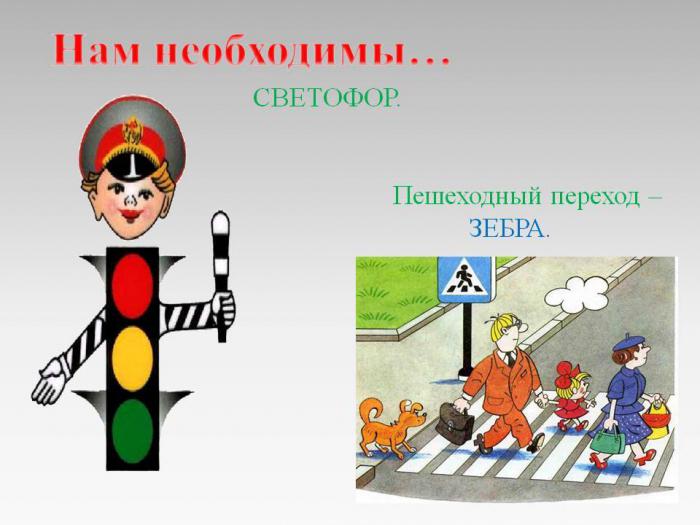 Regulated pedestrian crossings are sections of roads equipped with working traffic lights that operate in normal mode. As a rule, they are placed along street intersection lines. Car and pedestrian traffic lights are combined. Such crossings can also be found outside intersections. But they are equipped with traffic lights with a button that turns on the green signal on demand.
Regulated pedestrian crossings are sections of roads equipped with working traffic lights that operate in normal mode. As a rule, they are placed along street intersection lines. Car and pedestrian traffic lights are combined. Such crossings can also be found outside intersections. But they are equipped with traffic lights with a button that turns on the green signal on demand.
Off-street pedestrian crossings can be located either at the same level with the road or at different levels. They are divided into aboveground and underground. The construction of such facilities is very expensive. This is the only reason why both overground and underground pedestrian crossings can only be found on streets with high traffic flow. After all, a zebra crossing painted on the roadway in such places would lead to a decrease in road capacity.
Underground crossings for pedestrians are built not only under the roadways of highways, but also under railway tracks.
Aboveground corridors have the parameters of a bridge or viaduct. They are installed both over pavements and over railway tracks.
Rules
How do you navigate pedestrian crossings if the traffic light is not working or is missing? According to clause 14.1. According to the Russian Road Traffic Rules (RF Traffic Regulations), the driver is obliged to let people walking along the roadway pass.
The rules for crossing a pedestrian crossing also state that if there is a traffic light for cars or people at a zebra crossing, then you should wait until the green permitting signal lights up - and only after it start moving. In addition, the driver must give way to passersby walking across the road he is turning onto. This is stated in paragraph 13.1. Traffic rules of the Russian Federation.
For walks
What is a pedestrian zone? These are urban lands intended exclusively for people. It is prohibited to drive motor vehicles on them. The only exceptions are vehicles of route transport, special services, municipal vehicles, vehicles for the disabled, and for servicing stores. And, of course, only when the car does not have an alternative route. It should be noted that the first zones of this type appeared in Europe in the 1950s.
According to Russian rules
How is a pedestrian crossing generally designated? GOST requires signs to be placed on each side of the street near its boundaries. What is a pedestrian zone in Russian practice? This is an area with sign 5.33 installed on all sides along the perimeter. By the way, before it appeared, sign 3.2 “Movement is prohibited” was used. As a rule, the border of such a site is located where the road sign 5.34 “End of the pedestrian zone” is installed. No vehicles of any kind are allowed in this area. But you can sometimes find tram and pedestrian alleys. In this case, an exception is made for trams.
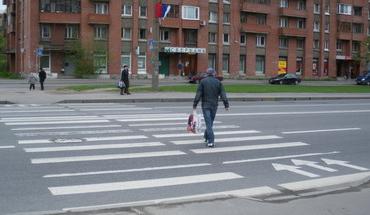
The first pedestrian street in Moscow was Arbat. Driving on it by car has long been prohibited.
Bridges for the population
Overground pedestrian crossings are off-street corridors for passers-by. They are made in the form of a kind of bridge. Only people can move on it. Such a crossing is usually located above railway tracks or a roadway.
Good afternoon, dear reader.
In the sixteenth article of the series "Signs traffic"The following signs of special regulations will be considered:
Bus and (or) trolleybus stop location.
- Tram stop location.
- Taxi parking area.
- Crosswalk.
- Artificial roughness.
We will talk about the features of installing these signs, as well as the violations associated with them.
In addition, according to clause 18.3 of the traffic rules in populated areas Drivers must give way to public transport that starts moving from the designated stopping place. For this violation, the driver will receive a warning or an administrative fine of 500 rubles.
A few more prohibitions related to stopping public transport: Turning around (clause 8.11 of the traffic rules) and reversing (clause 8.12 of the traffic rules) are prohibited there. The fine for these violations is provided for in Part 2 of Article 12.14 of the Code of Administrative Offenses and amounts to 500 rubles.
Tram stop sign
The road sign “Tram stopping place” is installed on the road in the following cases:
- To the right of the roadway if the tram tracks run in the middle of the road.
- To the right of the roadway on the road with one way traffic, if the tram tracks are located to the left of the road.
In addition, a duplicate sign is installed either at the beginning of the landing area raised above the roadway, or above the left lane this direction(on roads with 2 or more lanes for traffic in a given direction).
Please note that the "Tram Stopping Place" sign is installed on the roads in order to help the driver comply with the requirements of paragraph 14.6 of the rules:
14.6. The driver must give way to pedestrians walking towards a route station standing at a stop. vehicle or from it (from the door side), if boarding and disembarking are carried out from the roadway or from a landing area located on it.
For violating this clause of the rules, the driver will receive a fine of 1,500 rubles.
Taxi parking sign
The road sign "Taxi parking area" is used to designate the corresponding parking areas:
Since passenger taxis do not have an advantage over other road users, it is not possible to violate the requirements of this sign.
Pedestrian crossing sign
Road pedestrian crossing sign used to mark the boundaries of a pedestrian crossing, in the absence of appropriate markings on the road:
Please note that there are 2 different signs pedestrian crossing (5.19.1 - where the pedestrian goes to the left, and 5.19.2 - where the pedestrian goes to the right). The first sign is installed on the right side of the road, and the second, respectively, on the left. In this case (in the absence of road markings), signs are used to mark the boundaries of the pedestrian crossing.
I would like to draw your attention to the fact that in practice, pedestrian crossing signs different sides roads are sometimes installed strictly opposite each other, i.e. it turns out that the beginning of the transition coincides with its end. Naturally, a pedestrian cannot move around such a structure without violating the rules, and in some cases this can be used to their advantage.
Among the features of installing this sign, it should be noted that on roads with a dividing strip pedestrian crossing signs installed on each roadway separately. Those. one sign on each side of each roadway.
Let me remind you that pedestrian crossing coverage area determined by the following criteria:
- According to the markings, if any.
- According to signs 5.19.1 (start) and 5.19.2 (end), if there are no markings.
Currently, pedestrians have priority when crossing the road along unregulated crossings. If the driver does not allow the pedestrian to pass in time, he will receive a fine of 1,500 rubles.
In addition, turning around (clause 8.11 of the traffic rules) and reversing (clause 8.12 of the traffic rules) are prohibited at pedestrian crossings. The fine for these violations is provided for in Part 2 of Article 12.14 of the Code of Administrative Offenses and amounts to 500 rubles.
A pedestrian crossing is one of the special zones on the roadway. Without it, pedestrians cannot safely cross from one side of the road to the other. To make it easier to navigate, this part of the roadway is marked out in a special way. For example, with the help of artificial structures that can be located above or below the road. In addition, according to traffic regulations, pedestrian crossings must be marked with special road signs.
Near tram and trolleybus stops and in front of intersections, as a rule, they put up a special set of signs for people, or so-called “zebra crossings”. Such means are also used in other territories where the flow of people is quite large. It is in them that compliance with traffic rules becomes especially important. Ensuring order and regulating any changes on road sections are the responsibilities assigned to the traffic police. Previously, this organization was called the state traffic inspectorate or abbreviated as traffic police.
![]()
Adjacent territory and pedestrian crossing sign
Pedestrian crossings are called ground crossings if “zebras” are drawn at their location. They are precisely what are used to safely move from one side to the other. Of course, such parts of roads can be highlighted in other ways.
The simplest option is a pedestrian crossing without regulation. There are no traffic lights, but drivers are required to let anyone who has at least one foot on the zebra crossing pass. Usually such crossings are placed where there are not very many drivers. 5.19 is a type of sign that is used to designate such zones. Sometimes traffic lights are installed to equip a section of the road, but only a yellow signal flashes in them, or they are completely turned off.
Usage additional funds allocations in such zones have become a mandatory requirement since 2010. In particular, the following set of requirements is imposed on such zones:
- Mandatory presence of light animation for signs;
- Stripes appear not only white, but also additional orange ones;
- Sometimes so-called noise stripes are additionally applied;
- Also, four to five speed bumps are installed at different distances. Depending on how close the transition is, their frequency may increase;
- It is necessary to circle the sign itself with a yellow-green reflective edging;
- The installation of yellow flashing lights becomes mandatory;
- At least one speed bump must be installed before crossing;
- It is necessary to organize bright lighting of the area where pedestrians pass.
If the pedestrian crossing is adjustable, then it must be equipped with working traffic lights that operate in normal mode. Along the lines of street intersections, you can most often see these types of devices. Typically, authorities try to combine traffic lights for both pedestrians and cars. These types of equipment are sometimes installed outside intersections. Then a button is connected, when pressed, the traffic light switches to the green signal mode for pedestrians.
On one or on at different levels Off-street pedestrian crossings are located adjacent to the road. They can also be underground or above ground. True, in construction, these objects become very, very expensive. Therefore, most often, they are placed only on sections of roads where the flow of cars is really very large. Due to the fact that the presence of a zebra crossing reduces the throughput indicator.
Underground crossings can be installed under railway tracks and highway carriageways.
A viaduct or bridge is the name given to ground-type crossings. They are built both over railway tracks and overpasses.
Basic rules for the Pedestrian Crossing sign
If a traffic light does not work or is missing, it can be difficult to remember what rules to follow. Drivers are always required to give way to those who have entered a pedestrian crossing or are crossing the road, according to the Russian Traffic Rules, clause 14.1.
If everything is in order with the traffic light, then before you start moving, you must wait until the light turns green. The rules state this very clearly and clearly: if a driver turns onto a road, he must give way to pedestrians walking along it. Mention of such situations is easy to find in the traffic rules; just look at clause 13.1.
Sign “Pedestrian Crossing and its coverage area”
There are two different Pedestrian Crossing signs. On one of them the little man goes to the right, and on the other - to the left. For pedestrians, the coverage area is limited only to the area between these signs. If there is a zebra crossing, then the signs are valid only within its borders.
If there is no zebra crossing and the driver needs to let people pass, the the above rule. Then, when the markings are present on the road surface, they serve as a limiter. They do not have the right to fine a driver if a pedestrian crossed the road in the area where the rules apply, but not on a zebra crossing. In this case, the pedestrian violates the traffic rules.
In case of parking or stopping, the coverage area of the pedestrian crossing extends 5 meters in each direction. If there are no signs, then the action is limited to five meters on each side of the nearest zebra.
Russian rules for the Pedestrian Crossing sign
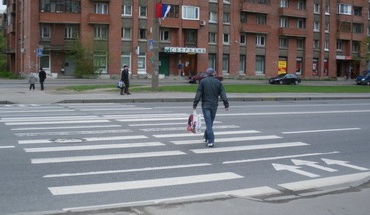 What designations for pedestrian crossings do we use? According to GOSTs, signs must be placed on each side of the street where its boundaries lie. In practice, we have pedestrian crossings - a type of territory where sign 5.33 is placed on all sides. “No traffic” sign 3.2. - one of which was used before 5.33 came out. And the sign numbered 5.34 marks the boundary of such areas.
What designations for pedestrian crossings do we use? According to GOSTs, signs must be placed on each side of the street where its boundaries lie. In practice, we have pedestrian crossings - a type of territory where sign 5.33 is placed on all sides. “No traffic” sign 3.2. - one of which was used before 5.33 came out. And the sign numbered 5.34 marks the boundary of such areas.
Where there are such signs, it is generally prohibited to travel by any type of transport. An exception is made only for trams. Arbat was the first street in Moscow that was intended only for pedestrians. It has always been forbidden to drive cars on it.
Pedestrian crossing sign at overhead bridges
Off-street corridors are called elevated pedestrian crossings. Such structures usually take the form of bridges and are intended only for the movement of people. Such bridges are placed either over wide roadways or over railway tracks.
What are the advantages of these designs?
- There is no need for 24/7 lighting. From the outside you can clearly see everything that is happening;
- There is no need to make any changes to underground communications;
- Lower cost when compared with underground corridors;
- High level of security.
The construction of overpasses requires additional engineering research, despite the apparent simplicity of construction, than during underground construction. The crossing should be built not low - to allow heavy vehicles to pass under it, and not too high - to avoid increasing the cost of the construction process.
Road sign number 6.7 - has the designation “overground pedestrian crossing”. It is included in the source category important information for traffic participants.
Sign "Underground pedestrian crossing"
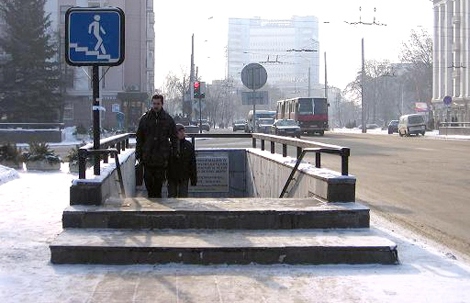
They are usually made in the form of tunnels. And they are placed either under the roadway or where there is railways. Steps lead down to such a tunnel from sidewalks and walkways. Today, special slopes are required for people with disabilities. disabilities, baby strollers and bicycles. An underground passage sign is always placed next to such a structure.
Underground pedestrian crossings appeared in our country during the Soviet era. At this time they were used exclusively as a connection. With the advent of the 90s and the collapse Soviet Union, pedestrian crossings have become spontaneous shopping arcades. Some crossings are closed at night, especially those combined with metro station lobbies.
Signs indicating underground pedestrian crossings are designated in GOSTs by number 6.6. .
The number of cars in the cities and villages of our country is increasing and increasing. It often happens that a simple city dweller, moving on his own two feet, experiences difficulties, even if he just wants to cross the street. In order to help their grief, a section of the road is set aside specifically for pedestrians. “Pedestrian crossing” is a sign showing this section.
When you see the “Pedestrian Crossing” road sign, you won’t confuse it with anything. A black man in a white triangle on a blue background is walking somewhere along a zebra crossing. In principle, there is no confusion here. By the way, the little man can move not only from right to left, but also from left to right. The first option is placed before the start of the transition, the second - at the end.
Let's take a closer look at the types of transitions.
Ground
This type is the most common. Except " Footpath", but he definitely exists, is present and special kind markings, the familiar “zebra” markings. Transitions can be adjustable. In this case, all road users obey the signals. This option is optimal for multi-lane roads with active traffic. If the traffic flow is not very intense, you can get by with an unregulated option. Here the driver is obliged as soon as the pedestrian steps on the zebra crossing. Naturally, the traffic sign “Pedestrian crossing” takes place in any case.
It should be noted that now not only in Moscow, but also in Russia, a pedestrian crossing, the traffic rules allow this, and are also highlighted additionally. Namely:
- lighting is installed in this area;
- another sign is hung directly above the roadway;
- speed bumps are installed;
- Orange zebra stripes are drawn between the white stripes.
Overhead
Most of all they resemble bridges. Both in appearance and in purpose. The road sign "Pedestrian path" in front of them is slightly different from the one described above. On a blue background, a white man is walking up the stairs - everything is intuitive. Such bridges are mounted over railway rails and the roadway. Most often they can be seen on large highways. What is the advantage of such transitions? Firstly, they provide high level safety (compared to ground-based). And no wonder, because no reckless driver or seasoned violator can get there - it’s impossible in principle. Secondly, in terms of money it will be cheaper than underground. Thirdly, during its construction there is no need to dig up underground communications.
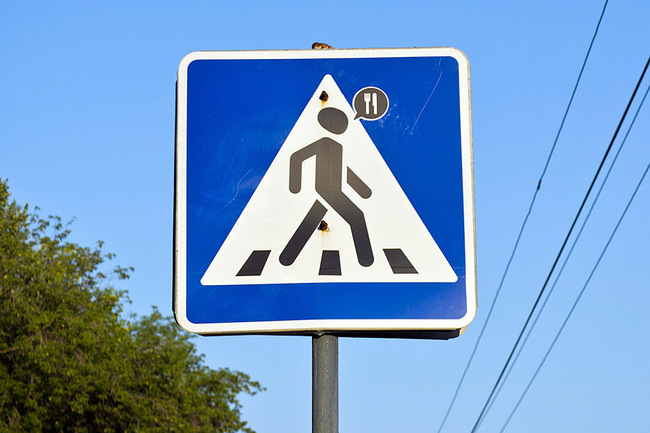
But what about the shortcomings? Perhaps the only drawback is the height difference. The elderly and sick will find it somewhat inconvenient.
Underground
The “Pedestrian Road” sign, or more precisely, the “Underground Pedestrian Crossing” sign, is almost identical to the overground one. Only the little man does not rise, but descends. Underground crossing It is a kind of tunnel under the road surface. Like the elevated one, it is absolutely safe for those who like walking. Plus the large space inside allows you to place outlets. And the difference in height is not great, three or four meters, no more.
But the disadvantage, and a very significant one, will be the cost of construction. How else? Excavation work, coupled with blocking streets and relocating utility lines, will cost a pretty penny.
Effective area of the Pedestrian Crossing sign
The coverage area of the Pedestrian Crossing sign is something that drivers should not forget about. Everything is simpler than it seems. If there is a “zebra”, then the border along its birthmark is determined. And if there is no zebra, then its width is equal to the distance between the signs. We have already written about them above.
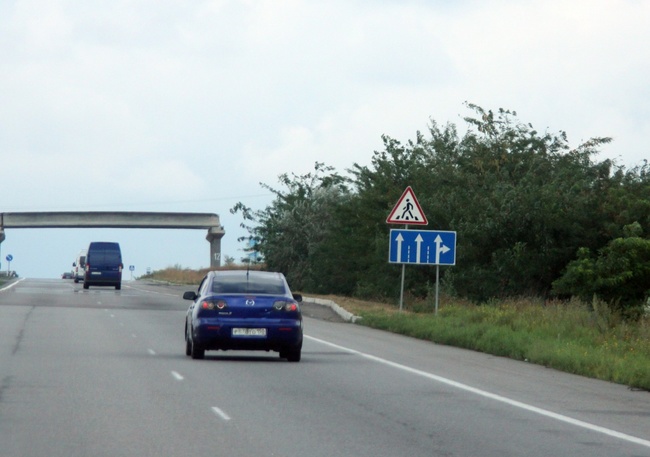
Kara
IN last years The punishment for such sins has become much harsher. If you didn’t let the notorious pedestrian pass in the area where the “Pedestrian Crossing” sign is valid, you will part with 1,500 rubles. Didn't stop at the stop line? Down with 800 rubles. So it's better not to take risks.
So, in this article you got acquainted with the important road sign. Be especially careful. Yes, the installation of the “ ” sign is done specifically so that pedestrians can cross the street safely. However, it would be naive to think that they will only cross the road along it. Most will go where it is shorter. And if something happens, the driver will be to blame, since he controls the source of increased danger. So in our country the responsibility for road safety lies with him.. We must never forget about this.




